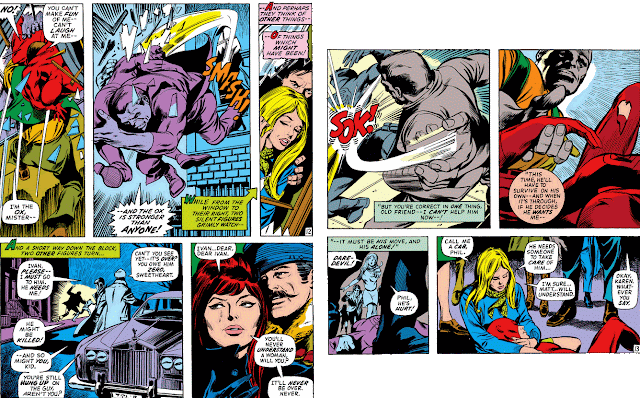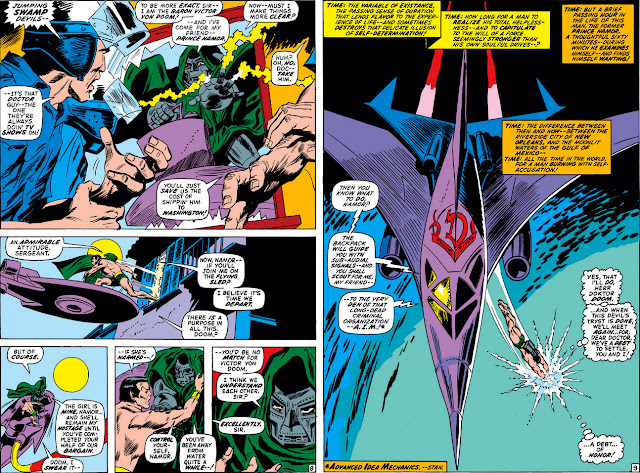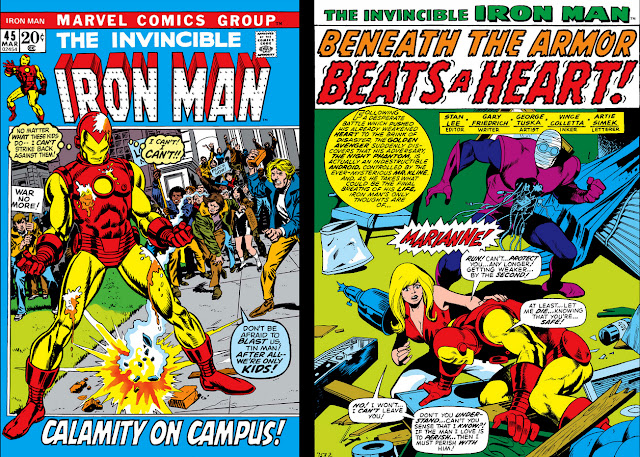What were some of you doing five decades ago? It's funny when you reach certain points where you find yourself recalling the world as it was then, and the realization hits that you lived during that period of time and lived through many of the events and changes which took place. For those of you in high school right now, you'll experience your own reflections of today's world in the year two-thousand seventy-two (!) -- and if you're like the rest of us, you're understandably not looking that far down the road, nor can you have a true conception of how your world, its people, its advances, and your own way of life will change.
Regrettably, it's safe to assume that by 2072 the price of a comic book will probably be around the cost of a monthly house payment, so be sure to factor that into your budget.
Fifty years ago, my own calendar would have put me at the year 1972, fourteen years old and looking forward to starting high school the next year. Here's a little of what my world looked like at the time:
-
NASA was one flight away from closing out its Apollo moon mission, where America established itself as a pioneer of a sort but eventually realized it was spending a lot of money just to collect moon rocks;
- The SX-70 Polaroid camera was introduced, giving us film prints which developed themselves "right before your eyes"--an alternative to dropping your film off at "photo marts," but still too slow for those who reasoned that shaking the print feverishly would speed up the process (a reminder to think twice before following a wacky trend);
- Born in April of that year: actresses Jennifer Garner, Jenni Garth and Carmen Electra;
- The United States was nine months away from withdrawing its forces from Vietnam;
- The world's first law to officially recognize change of gender passed in Sweden;
- Winners of the 44th Academy Awards included The French Connection, Jane Fonda, Cloris Leachman, and Gene Hackman;
- The price of gas was at $0.55/gallon; the cost of a new home was around $30,000; a new car, $3,800; average rent, $165/mo.
- The home videogame industry took its first baby step with inventor Ralph Baer's patent for "A Television Gaming Apparatus and Method" (i.e., the home video game console).
But if you were a Marvel Comics reader in April, 1972, your focus away from school was probably on the comics stand at your local drugstore, shopping mart or whatever distributor carried comic books in your town, thanks to the Bullpen Bulletins page which often included the Marvel Checklist. If your comics collecting was in full swing, here's a "snapshot" of what Marvel Comics readers were plunking down their 20¢ for.
New Yorkers didn't have much time to appreciate those April showers when the "angel" known as Gabriel descended from the sky to warn them that their world was about to end. Hearing the intruder's name, the fearful among them (i.e., everybody) interpreted that in a biblical sense, and panic hit the streets, with even the Fantastic Four proving to be helpless against his power. But the Silver Surfer intervened, and this issue gave us the showdown between the Surfer and what turned out to be the second herald of Galactus.
Meanwhile, in Asgard, which at that point in time had been transported far from normal space, tragedy appeared imminent for the mighty Thor when the deadly Mangog, intent on revenge, held the city's ruler, Odin, in his grip and demanded no further interference with his plans from Thor upon pain of death for his father. Yet in the end, when Thor and Mangog met in final battle, the unthinkable turned out to be inevitable.
Back on Earth, if you were part of a biker gang menacing the mutant Lorna Dane, you also saw death bearing down on you--albeit in the form of the Hulk, following his rather forceful exit from New Mexico's Project Greenskin "Hulkbuster" base. Of course, Lorna had something to say herself about these ruffians putting her in danger.
Elsewhere in New York, apparently Spider-Man was too busy fending off another Spider-Slayer to watch Gabriel and the Surfer throw down--and this time, the personally-manned Slayer was able to capture the web-spinner and deliver him like a trophy to a roomful of gangsters.
Previously, however, Spidey had other worries--such as our villain, Spencer Smythe, making use of police surveillance cameras to get a good look at his enemy's true identity. Fortunately, Smythe didn't know that face from Adam--allowing Peter Parker to come up with a way to pull the wool over his eyes, by way of another mask.
And hey, why weren't the Avengers
helping to kick Gabriel's butt? Or at the very least, helping to save the lives of helpless, drowning civilians when the creep flooded the city? Well, from the looks of things on Page One of the issue published that month, they were busy investigating a missing person--a fellow Avenger who failed to return from the Kree-Skrull War.
But as we've seen on the cover, this issue had danger waiting in the wings--the mysterious Mr. Tallon, an instigator who turned out to be Ares, God of War!
TROUBLE IS NOT IN YOUR SET, in 1972, was likely directed to television viewers who were in the habit of walking up to their television and whacking it on the side as many times as it took to bring the picture back.
Over in his own mag, Captain America was battling the evil plan of the Red Skull, who unleashed yet another Sleeper on the world--one that Cap handily dealt with, so that he could race back and make that Avengers meeting.
Daredevil, the Man Without Fear, had cause to be a little fearful of the return of the Ox, who was dying from the effects of lethal radiation exposure and appears to want to take Daredevil with him. And as we can see on the issue's cover, he's opting for the scenic route.
And yet, when these two do take the plunge, a thirty-floor fall is a trifling matter, with both somehow landing safe and sound and even continuing their fight without even needing to dust themselves off. (Though to no avail for DD. You've heard the old saying: "If the fall doesn't get you, the Ox will.")
Which seems as good a time as any to pivot to Dr. Doom and the Sub-Mariner, who are in Mississippi (with no heralds or plummeting heroes to worry about, thank goodness)--where Namor, bereft of memory, is having a dispute with Doom about being conscripted to assist the master of menace in a scheme against A.I.M. involving the Cosmic Cube.
Eventually, however, Doom gets his way--having one of his men kidnap Namor's new friend, Cindy Jones, to ensure his cooperation--and the two begin their mission.
We then spin the comics rack to transport us from the Gulf of Mexico to the moonlit hills of Transylvania, where Frank Drake and his girlfriend have come to investigate his inheritance but instead encounter a legacy of darkness when Frank meets his ancestor, Dracula, the Lord of Vampires--the opening tale of an ambitious new series begun by Gerry Conway and Gene Colan (who from the looks of things were certainly busy that month).
Our globe-trotting continues to Antarctica and the Savage Land, where that domain's lord, Ka-Zar, is approached by visitors who attempt to convince him to return with them to civilization. But there is one last matter to be dealt with--a tribe of savages that Ka-Zar is forced to engage with when his entreaty of peace is bluntly refused.
Two notable mags show up on the racks during March of this year, each just starting out bimonthly--Marvel Feature (featuring the Defenders), its second issue temporarily placing the book on a tri-monthly schedule, and Marvel Team-Up, which of course turned out to be a successful concept that became mostly a vehicle for Spider-Man.
Another bimonthly series, Amazing Adventures, has by March of '72 booted the Inhumans from its pages and brought in Hank McCoy, who breaks from his past association with the X-Men by becoming a character who for now must operate solo, for reasons which become clear.
The Golden Avenger, Iron Man, was also briefly shifted to bimonthly publication during March following his book (along with other titles) being published in a larger format. March and May see the book back to the smaller page count, and Iron Man squaring off with the Guardsman in a battle which occurs in the backdrop of a student protest turned violent.
As for the X-Men, their bimonthly title was on hiatus at this time and offering only reprints of prior stories. In April, that would have been the return of the Mimic, a story originally published at the end of 1966.





































11 comments:
Pedants corner:
"If you were a Marvel Comics reader in April 1972..."
In Britain and Ireland, where the time it took to import American comics meant that the cover and on sale dates were the same, yes (only you'd have plunked down 6p), but in the US you'd have bought these comics in January '72, right?
Sorry Comicsfan, sometimes I can't help myself...
All the same, thanks for the post, as this was an enjoyable snapshot of the time. And one I hope you'll follow up at some point in the months to come, since '72 was an interesting year for Marvel (as Tomb of Dracula #1 here hints, they were beginning a period of expansion - "Phase 2 of the Marvel Revolution" as they used to call it in ads and Stan Lee's Soapbox iirc).
And - obviously more important - this is when I started reading American comics! Back in the the days when even an objectively terrible comic like Amazing Adventures #11 could capture your imagination... (;
Although most of my early ones were DCs - hey, everyone had heard of Superman and Batman (plus, Jack Kirby was working there at the time, and his covers were always appealing) - but Marvel starting up local reprint titles later in '72 made it a lot easier to follow ongoing series and swung things the other way for quite a while.
-sean
Just had a quick look online at April '97 cover dated Marvel comics - yikes!
You're a braver man than I am, tackling that lot Comicsfan.
-sean
I was only 6 in 1972 and I'd never heard of Marvel comics. I didn't discover Marvel until November 1974 and my first ever Marvel comic was Planet Of The Apes (UK version) #5.
But 1972 was a big year for Marvel's British fans because on September 30th the first ever Marvel UK comic was launched - The Mighty World Of Marvel #1 featuring the Hulk, Spidey and the FF.
sean, given that I wasn't exactly keeping an At-A-Glance date book at 14 (or at any other time in my life, actually) which kept a record of my comings, goings, and appointments throughout any given month, I felt it was best for the sake of consistency and accuracy to always take the date of a comic book from its indicia on the title page(s). You can't go wrong with wording that states, plain and simple, "April, 1972 issue." ;)
Like yourself, I mainly cut my Marvel teeth on its reprint titles after purchasing an issue of Sub-Mariner and going from there. They also kept a lot of titles at the local Boys Club I used to hang out at, which probably helped to light the fire since there were a good deal of books with Kirby work on the shelves. As for following up with similar posts, I don't see why not at this point--it was fun revisiting this older work. (And even putting together the '97 post was a memorable experience!)
I was 7 in 1972 and just making the switch to Marvel, via Spider-Man by Conway and Andru, after a few years of being Batman obsessed (the tv show and all). Those years will always reflect "My Marvel Universe", Sal Buscema on Cap, Andru on Spidey, etc.
1972 saw me strutting around as a 14-year old as well! Starting to feel a wee bit self-conscious buying "kiddie comics", but the inner-nerd could not be denied. I'd "graduated" from DC to Marvel a couple of years earlier, so all these titles are very familiar (several which I still own). Nice saunter down memory lane.
Those low-low 1972 prices make for good copy, but I could not resist running them thru the inflation history converter to 2022 equivalents:
$30,000 for a house = $200,270. Depending entirely on the area and market, that is a great bargain! A lot less than the roof over my head right now.
$3800 for a car = $25,367. Rather depends on whether that $3800 was buying a plain economy model or a more luxurious whip.
$165 rent = $1100. Sadly, no change to the modern world.
20¢ for a comic = $1.34. We were getting a helluva deal! (From the pundit pieces I've read, this was because comics back then sold enough to achieve profit from sheer volume with kids being their customer base. In the modern era, they are more "artisan pieces" for the discriminating "adult" connoisseur)
1972: nine years old, reading comics for about 12 months; I bought any Marvel I could find as, due to spotty distribution here in Australia, apart from titles with high print numbers like Fantastic Four and Avengers, there was no guarantee that finding Amazing Adventures one month meant finding the next issue the following month. And I still have the first three comics I ever read - Conan The Barbarian #10, Gold Key's Microbots #1-and-only and Monsters On The Prowl #14. For me, 1972 marked the beginning of the Age Of Discovery Of Comics. As for 1997, my impression of 1990s Marvels is crappy stories, anatomically implausible art and a lot of characters grimacing and growling; it was the era of my personal Marvel Implosion when I cut many titles and shifted much more to DC and Independents. But I look forward to the post and what you (re)discover.
Sal Buscema on Cap was surely a hard habit to break, Scott. But in post-Kirby work I enjoyed both Romita and Colan before him, and the talent that accompanied Ed Brubaker's run I felt was just excellent.
Murray, I'm always stunned to see what New Yorkers pay in rent (or even purchase price) for space that's probably half the square footage of my house. It always seems a seller's market in that respect. A comics habit in addition to that would probably send the owners into debt. :(
Unknown, your points on the 1990s books are well-taken. I'll just say for now that the 1997 post will take the form of a two-parter. (With good reason, which should become clear when the time arrives. ;) )
I was three in '72, so any comics from this period I picked up much later in the form of back issues or reprints. But looking at this stuff, (some issues I have, some I don't) I gotta say, this looks like a pretty great month for Marvel. Even with the earlier loss of Ditko and Kirby, they were firing on all cylinders.
Thor, particularly, was great back then. I love the Mangog story arc. And Tomb of Dracula debuts!
They certainly weren't resting on their laurels.
It was fun to look at this stuff. A nice way to wind down a Monday.
M.P.
Thanks and yeah, Sal made an impression on me due to my age, but by the time I was a teen Cap was handled by a variety of artists before the all too brief Byrne run, and then Zeck afterward. Romita Sr, of course, was a legend to me and I spent much of the early 80s buying as many of his ASM as I could get my mitts on (I am still collecting them at age 57, happily). And I agree about Brubaker's run, and afterward.
Love your blog, it really brightens my day.
You mean you weren't reading Marvel comics when you were three M.P.? What kind of excuse is that?
No RFO, QNS or KOF for you.
-sean
Post a Comment